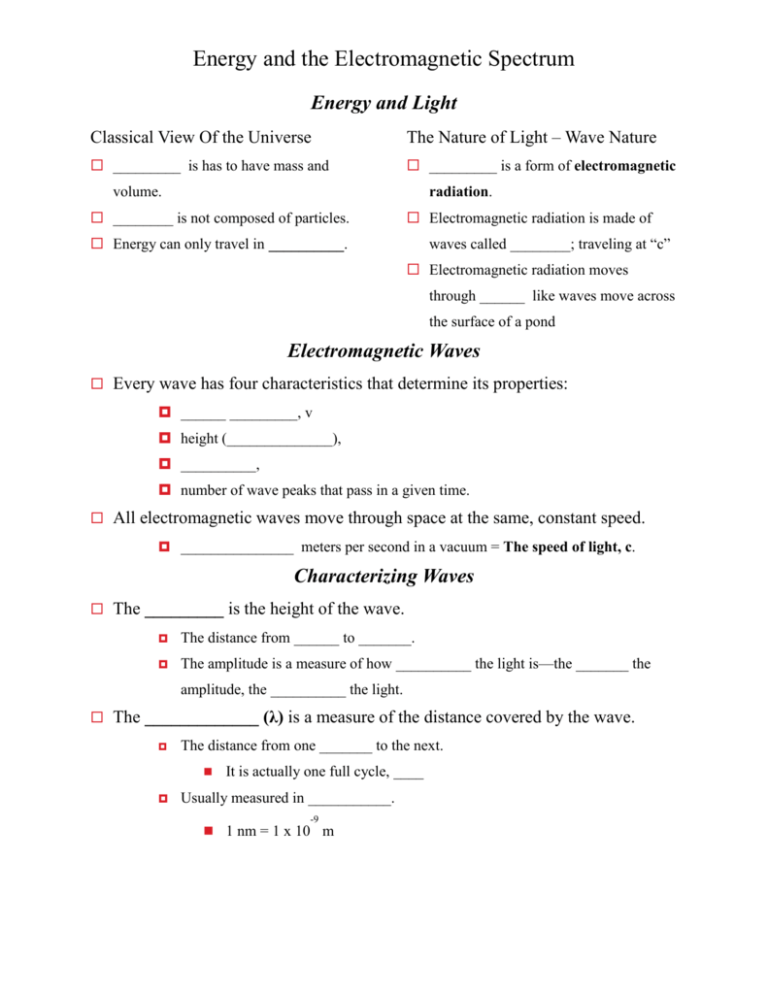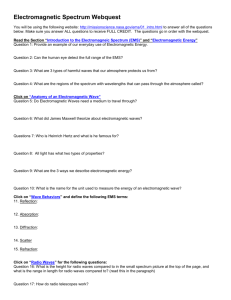Electromagnetic Waves - Coronado High School
advertisement

Energy and the Electromagnetic Spectrum Energy and Light Classical View Of the Universe The Nature of Light – Wave Nature _________ is has to have mass and _________ is a form of electromagnetic volume. radiation. ________ is not composed of particles. Electromagnetic radiation is made of Energy can only travel in __________. waves called ________; traveling at “c” Electromagnetic radiation moves through ______ like waves move across the surface of a pond Electromagnetic Waves Every wave has four characteristics that determine its properties: ______ _________, v height (______________), __________, number of wave peaks that pass in a given time. All electromagnetic waves move through space at the same, constant speed. _______________ meters per second in a vacuum = The speed of light, c. Characterizing Waves The _________ is the height of the wave. The distance from ______ to _______. The amplitude is a measure of how __________ the light is—the _______ the amplitude, the __________ the light. The _____________ (λ) is a measure of the distance covered by the wave. The distance from one _______ to the next. It is actually one full cycle, ____ Usually measured in ___________. -9 1 nm = 1 x 10 m Energy and the Electromagnetic Spectrum The ______________ (ƒ) is the number of waves that pass a point in a given period of time. The number of waves = number of _________. -1 Units are ________ (___), or cycles/s = s . 1 ___ = 1 s -1 The total _______ is proportional to the amplitude and frequency of the waves. The________ the wave amplitude, the _______ force it has. The more ___________ the waves strike, the _______ total force there is. C, frequency and wavelength Wave speed, frequency and wavelength have _____________ _____________. Using __ = ___________ or ______________ can be found. Example what is the wavelength of a wave of light if it has a frequency of 14 3.2 x 10 hertz? Energy and the Electromagnetic Spectrum Light Particles and Planck’s constant Particles of Light Planck’s Constant Scientists in the early _____ century Planck ’s constant is a physical constant showed that electromagnetic radiation reflecting the sizes of energy ________ was composed of particles we call (_________) in quantum mechanics. It is named after ____ ________, _________. __________ and Albert Einstein. one of the founders of quantum ________ are particles of light theory, who discovered it in energy. 1900. ____ wavelength of light has _______ with that amount of energy. The equation is _________ where E = ________, h = _________________ (______________), and f = frequency. Using Planck’s equation, E = h x ƒ What is the energy (Joules) of Violet light with a frequency = 7.50 x 14 -1 10 s ? -11 Find the energy of light, wavelength is 4.06 x 10 m. Energy and the Electromagnetic Spectrum The Electromagnetic Spectrum The electromagnetic spectrum is the _________ of all possible frequencies of _______________ ____________ . The color of the light is determined by its wavelength. The electromagnetic spectrum extends from _____ frequencies used for ________ ________ communication to _________ radiation at the short-wavelength (____-____________) end. The Electromagnetic Spectrum and Photon Energy Short wavelength light have photons with _________________ = __________________ Radio wave photons have the _____________ energy. Gamma ray photons have the _____________ energy. ______-energy electromagnetic radiation can potentially damage biological molecules. Ionizing radiation The waves fit between atom-atom bonds, and ________________ the atoms loose Order the Following Types of Electromagnetic Radiation: Microwaves, Gamma Rays, Green Light, Red Light, Ultraviolet Light, By wavelength (short to long). By frequency (low to high). By energy (least to most).






